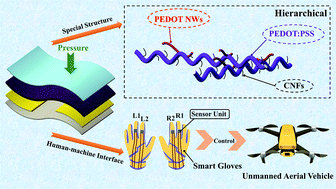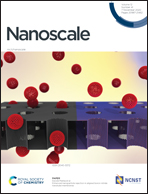Highly sensitive and wide-detection range pressure sensor constructed on a hierarchical-structured conductive fabric as a human–machine interface†
Abstract
With the booming development of flexible pressure sensors, the need for multifunctional and high-performance pressure sensor has become increasingly important. Although great progress has been made in the novel structure and sensing mechanism of the pressure sensor, the trade-off between the sensitivity and the wide-detection range has prevented its development, further restricting its application in wearable human–machine interfaces (WHMIs). Herein, a novel pressure sensor based on the hierarchical conductive fabric was fabricated and purposed as a WHMI. Poly(3,4-ethylenedioxythiophene) nanowires (PEDOT NWs) and cellulose nanofibers (CNF) were stacked on a conductive poly(3,4-ethylenedioxythiophene):poly(styrene sulfonate) (PEDOT:PSS) fabric to form a special spatial multi-level hierarchical structure inside the fabric, which is a breakthrough for the improvement of the sensor's performance and makes the fabrication process of in situ polymerization suitable for large-scale production. The multi-level hierarchical structures endowed the pressure sensor with characteristics of high sensitivity (15.78 kPa−1), a wide-detection range from 30 Pa to 700 kPa, and outstanding stability toward compression and bending deformation. Benefiting from its excellent performance, a human–machine interface based on arrayed pressure sensors and signal processing system can control the illumination of the LED array and effectively capture finger motion to control the eight-direction movement of an unmanned aerial vehicle (UAV). This improved performance of the pressure sensor based on the hierarchical conductive fabric made it a widespread application in intelligent fabric, electronic skin, human–machine interfaces, and robotics.



 Please wait while we load your content...
Please wait while we load your content...